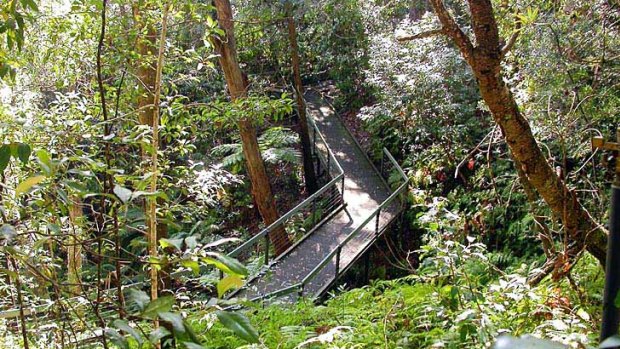
Precious land ... a walkway at Booderee Botanic Gardens.
Bush tucker and lessons in traditional medicine make Booderee much more than a botanic garden, writes Bruce Elder.
The Commonwealth government's decision to excise the "Jervis Bay Territory" from NSW always seemed like a wacky idea that only a country "girt by sea" would regard as essential.
The argument for it went like this: Canberra being landlocked, the Commonwealth needed access to the sea. Simple. In 1915, the area bounded by Jervis Bay to the north, coastal cliffs to the east, Wreck Bay to the south and Sussex Inlet and St Georges Basin to the west all became part of the Australian Capital Territory.
In 1951, the Canberra-based Australian National Botanic Gardens, needing a frost-free area for research into mild-climate plants and knowing that Canberra was too cold in winter for its needs, developed part of an old farm near Wreck Bay to use as a mild-climate botanic annex.
The land had been known as Bherwerre and was used by the timber and dairy industries from 1900. From the 1950s for the next 44 years, this annex was known as the Jervis Bay Botanic Gardens. The only criterion for plantings at the annex was their need to be climate suitable. The small local Yuin and Wadi-Wadi Aboriginal community at Wreck Bay worked at the gardens. Today many of the paths, rock walls and garden beds are the result of their labours.
In 1995, the botanic gardens were handed over to the Wreck Bay community, renamed Booderee Botanic Gardens and became jointly managed by locals and the federal Director of National Parks.
Significantly, the garden's non-indigenous plants were slowly removed. Fast forward to 2012 and Booderee Botanic Gardens is an excellent and harmonious collection of the flora of south-eastern Australia's coastal environment.
When we meet with Bernie McLeod, the garden's curator, he rightly and proudly declares that Booderee is "the only Aboriginal-owned botanic gardens in Australia". It is a source of great local pride. The gardens cover 80 hectares of the larger Booderee National Park and the latter itself attracts 500,000 visitors a year.
As we wander through the garden's peaceful woodlands, McLeod plucks a leaf from a lemon-scented tea-tree, crushes it and invites us to smell. Further along, bottle brush (callistemon), waratah and gymea lily are in bloom and McLeod points out the dazzling floral displays of the orange, pink and yellow flowering gums.
We walk past stands of turpentine, blackwood and bloodwood as he remarks that the land is home to red-belly black snakes and diamond pythons; that 10,000 pairs of eastern long-necked turtle inhabit the garden's Lake McKenzie; and that more than 200 species of birds have been recorded in the surrounding national park.
As McLeod guides and educates us, we make our way to open parklands adjacent to the land's old farm buildings (now called the Waratah Lawn) and see crimson rosellas and rainbow lorikeets swooping and racing through nearby woodlands. Later we hear a kookaburra, see wood ducks on the shores of Lake McKenzie and watch as a satin bowerbird goes about the business of building its nest next to a walking trail.
These gardens are idyllic. There are 3.7 kilometres of easily accessible tracks through wooded landscape, across open lawns and beside Lake McKenzie. The trails pass by the Heath and Woodland Garden, which focuses on south coast flora; the Casuarina Lawn (particularly popular with glossy black cockatoos); the Waratah Lawn (ideal for picnics); Rainforest Gully and the Koori Garden (bush tucker and medicine).
McLeod points at the sap dripping from a bloodwood gum and says it can be used to numb gums, so is considered a traditional cure for toothache. He points out a cabbage tree used by Europeans to make hats and says the local Koori community traditionally used it for both food and as rope.
During school holidays, the Booderee gardens host a program of activities for children, including learning about bush tucker and medicines, Aboriginal tools and technology, games and campfire yarns. A hosted twilight walk is also popular. It all combines to make Booderee more than just a botanic gardens.
Later, we accompany McLeod from the gardens to a superb viewing platform, built at the old lighthouse on the end of Stoney Creek Road in Booderee National Park. From the platform we see seals on the rocks below and in season (June-July and September-November), it is regarded as one of the best whale-viewing spots on the coast.
From here, we move on to the pristine white sand beaches of Jervis Bay and to Green Patch, then walk around the cliffs to watch the dramatic tidal ebb and flow between the Jervis Bay mainland and Bowen Island.
Later, we drive to Wreck Bay village. McLeod advises the botanic gardens itself can be explored in half a day but that people who really want to experience the beauty and tranquillity of the entire national park usually take at least three days. I wish I had more time here, too.
FAST FACTS
Getting there
Booderee Botanic Gardens is 192 kilometres (about 2-hours' drive) south of Sydney via the Princes Highway and Jervis Bay Road. The gardens are open daily, including public holidays. Admission is included in the Booderee National Park use fee ($10 a car; $5 concession). Pay at the park entrance station.
From October 1-April 30, the Booderee Botanic Gardens is open 9am-5pm (Mon-Fri); 8am-6pm (weekends and public holidays, closing 5pm once daylight saving ends). From
May 1-September 30, the gardens are open 9am-4pm daily. Phone 4443 0977; see booderee.gov.au.
More information
environment.gov.au.
Sign up for the Traveller Deals newsletter
Get exclusive travel deals delivered straight to your inbox. Sign up now.